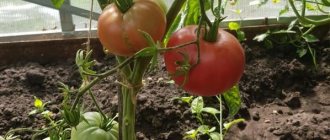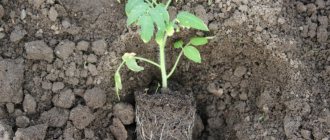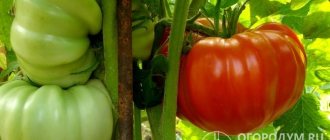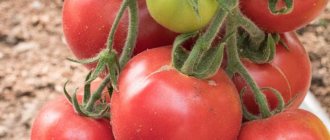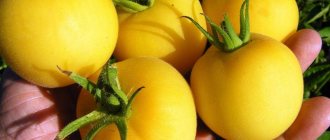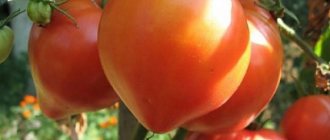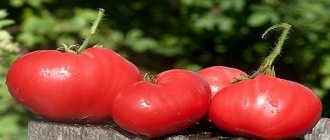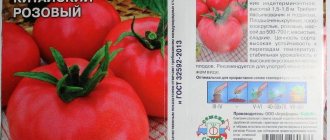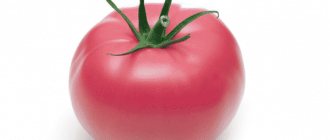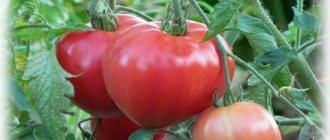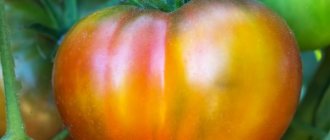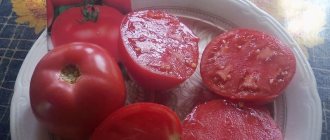Vegetable growing » Tomatoes
0
2431
Article rating
Kira Stoletova
Tomatoes are one of the most delicious and healthy vegetables that can be grown at home without much effort. In modern times, breeders have developed so many different varieties that it is very difficult for summer residents and vegetable growers to choose any particular type. Professionals recommend: if a vegetable grower will plant seedlings in open ground, then it is necessary to choose a variety that can withstand the climatic conditions of the region.
Description and characteristics of tomato variety Pink Souvenir
Tomato Pink Souvenir is a really good choice, since the yield of these tomatoes is quite high. Accordingly, anyone who plants it will rejoice in both the quantity of fruits and its taste.
Varietal characteristics
The Pink Souvenir tomato is one of the pink-fruited species, which is why it got its name. It is a hybrid form of culture, so it will not be possible to collect planting material on your own. But, despite this, many gardeners prefer to plant Pink Souvenir on their plot. Therefore, you should understand what advantages it has.
History of selection
This hybrid was bred more than 15 years ago. Its originator is the joint stock company “Sortsemovoshch”. The company specializes in the development of new types of tomatoes for cultivation in the Leningrad region and the North-West region of Russia. But, despite this, the hybrid Pink Souvenir is zoned everywhere, and it can be grown in all regions.
The Pink Souvenir tomato was included in the State Register in 2004 and is recommended for cultivation in open ground.
Main characteristics of the Pink Souvenir variety
This hybrid is one of the early ripening species. Harvesting can be done 80-85 days after sprouts appear.
Bush
Tomato Pink Souvenir is characterized by low-growing bushes. This species is determinate, so the growth of its shoots is limited. The height of the bushes does not exceed 60 cm. The shoots are densely leafy, so sunburn does not appear on the fruits even in the hottest periods of the year.
The leaves of the Pink Souvenir are medium in size and light green in color. The inflorescences are simple. The first fruit cluster is formed above the 5-7th leaf, and the subsequent ones - after 2. Up to 7 tomatoes are formed on each of them.
Productivity and fruits
Pink Souvenir tomatoes have a regular round shape. The average weight of each is 80-120 g, but individual specimens weigh 150 g. When ripe, the tomatoes acquire a uniform pink color with shine. This species is distinguished by its friendly yield of fruits.
Note! Pink Souvenir tomatoes do not have a green spot on the stalk, which is common to many species.
The pulp is sugary, the skin is thin and dense. Pink Souvenir has a pleasant sweetish taste with a slight sourness. The yield is 8 kg per 1 sq. m.
This hybrid belongs to the salad category, so the fruits are recommended to be consumed fresh. The Pink Souvenir can also be used for recycling. You can make sauces, pastas, and salads from tomatoes.
Note! Pink Souvenir tomatoes are resistant to cracking.
Immunity to diseases
This hybrid is characterized by relative resistance to common crop diseases. Therefore, it requires preventive treatment of bushes throughout the season.
It is recommended to start spraying the bushes 10 days after planting in a permanent place, and repeat every 2 weeks.
Advantages and disadvantages, differences from other varieties
Since there are a lot of pink-fruited tomatoes, it would be interesting to understand why experienced gardeners highly respect the Pink Souvenir variety. Its yield is not prohibitive, the fruits are not gigantic, although very pretty. But not everyone needs huge tomatoes: they are good for salads, but some people like to eat several tasty tomatoes without the help of a knife. A pink souvenir is very suitable in this situation. It has the following advantages:
- very high yield for a small plant;
- excellent taste of fruits with notes of honey;
- good presentation of tomatoes;
- versatility of crop use;
- no danger of fruit cracking when weather conditions fluctuate;
- high resistance to both low and very high air temperatures;
- good transportability and keeping quality of the crop.
Data regarding the variety's resistance to disease are contradictory. The State Register of the Russian Federation is silent on this point, although for most varieties it does not ignore it. Based on reviews from gardeners, we can conclude that during rainy, cold seasons, the likelihood of fungal diseases is present, so preventive spraying of plants in problem regions should be carried out.
It is difficult to cover the entire variety of pink-fruited tomato varieties and hybrids in a few sentences. It seems that just recently, a few decades ago, they were considered almost exotic. But at the moment there are more than fifty registered varieties, the name of which directly involves the adjective “pink” in one case or another, and how many more can do without this term! It must be said that most of these varieties have no regional restrictions and are grown everywhere, although some only in greenhouses.
The vast majority of rose-fruited varieties are salad varieties, which is not surprising: for some reason, they are more likely than other tomatoes to have a sweet taste, and in many of them it is rated by tasters as excellent. The difference between the Pink Souvenir and many other varieties is the uniformity of the fruits, their almost ideal shape with a very good yield for a determinate variety. Actually, almost half of pink tomatoes are determinate.
It’s strange, but among pink tomatoes, a relatively small part has a rounded fruit shape: as a rule, large-fruited varieties are either heart-shaped or flat-round. Round tomatoes from the determinate variety Pink Miracle. They are very similar to the variety in question, have an excellent taste, but cannot boast of high yield; the clear advantage of the variety is its very early ripening. The Pink Morning variety has the same drawback, although its rounded fruits are almost three times larger than those of the Pink Souvenir. One of the best-tasting fruits is the determinate variety of Novosibirsk selection, Pink Honey, but its yield is low.
The name of the tomato Pink Honey contains its main characteristic, but the yield of the variety is low
If we ignore the shape of the fruit, then, of course, it is quite possible to choose a worthy replacement for the Pink Souvenir variety, but when living in hot regions, we must not forget that there are very few varieties that normally set fruit at high air temperatures, and this is clearly advantage of the Pink Souvenir variety.
Pros and cons of growing
Like all species, the Pink Souvenir tomato has strengths and weaknesses. Therefore, before making a final decision, you need to familiarize yourself with them.
Advantages of the Pink Souvenir:
- high productivity;
- friendly ripening of fruits;
- easily tolerates transportation and long-term storage;
- excellent taste;
- excellent presentation of tomatoes;
- increased content of nutrients in tomatoes;
- able to set fruit even at temperatures above +30 degrees;
- easily tolerates changes in temperature and humidity;
- versatility of use;
- tomatoes are resistant to cracking.
See also Tomatoes Mystery of Nature: description and features of growing a productive variety
The disadvantages of this hybrid include the fact that the bushes need support, since when the fruits ripen, the bush may tilt. It is also necessary to partially plant the plants up to the first flower cluster.
Preventive measures
This variety is susceptible to some diseases
Like any other plant, “Pink Souvenir” has a number of dangerous diseases that partially or completely affect the bush. The most famous of them:
Late blight
A fungus that attacks fruits, when it changes its color and spots appear on the lower leaves, this indicates that the plant is infected. For treatment, the bush is treated with copper-containing and saline solution.
White rot
The description of the disease states that it affects only ripe tomatoes; a white coating appears during storage. The main source of distribution is soil. Preventive measure: treating the bush with phytosporin.
Streak
TMV (stands for tobacco mosaic virus), together with the potato virus, is the cause of the development of the disease. Another sign is if brown stripes appear on the stalk or branches.
The crop begins to dry out, the most dangerous thing is that the virus is transmitted through seeds and remains in the ground. To prevent further development of the disease, the seeds are first left in a weak solution of nitrate or potassium permanganate. Additionally, you can spray with a solution of salt and copper sulfate.
Gray rot
Another fungal disease that affects the stem, fruits and leaves. Initially, small white spots appear, which after a few days transform into a gray fungus. The upper part of the crop fades, the leaves begin to turn yellow.
The disease develops during fetal formation. If infected bushes appear in the garden bed, they must be destroyed immediately, as there is a danger that the fungus can be transmitted. Regarding safety measures, you should try to minimize watering to avoid excess moisture.
Spider mite
This disease is dangerous because the crop begins to dry out and its leaves fall off. The first thing you need to do is treat the plant with a medicinal solution; alternatively, Fitover can be used for these purposes. In addition, nearby weeds are destroyed and the bush itself must be dug up.
Formosa or brown rot
One of the most common diseases affecting the “Pink Souvenir”. Initially, it appears on the stalk, after which the ripened tomatoes become covered with brown spots, which then lead to rotting of the fruit. To prevent this bacterium from spreading in the area, you need to minimize the use of fresh organic fertilizer as much as possible.
Landing
This hybrid can be grown in seedlings or without seedlings. The first option is preferable for the central and northern regions, and the second for the southern regions. When growing Pink Souvenir seedlings at home, you must follow certain rules.
Preparation of planting material and soil
For sowing seeds, it is recommended to use wide but shallow containers with drainage holes. Their height should not exceed 10 cm.
Soil for planting can be purchased at any specialty store or prepared yourself. To do this you need to mix:
- turf (2 hours);
- peat (1 tsp);
- humus (1 tsp);
- river sand (1 hour).
To disinfect the soil, you need to water it with a strong solution of potassium permanganate and dry it slightly after that.
Seeds should also be prepared before planting. To improve germination, they need to be kept in a solution of Zircon or Epin. How long to soak them is indicated on the packaging of the preparations. After processing, it is recommended to dry the seeds a little until they become friable.
Sowing dates and patterns
It is necessary to sow the seeds of the Pink Souvenir for seedlings 55-60 days before transplanting to a permanent place. Therefore, the second half of March is considered the optimal period.
Landing algorithm:
- Place substrate in containers.
- Water generously and wait until the moisture is absorbed.
- Level the surface.
- Place the seeds at a distance of 2 cm from each other.
- Sprinkle them with soil and moisten the surface with a spray bottle.
After planting, cover the containers with glass or film and place in a dark place with a temperature of +23-+25 degrees. Keep it in this mode until shoots appear.
Expert opinion
Stanislav Pavlovich
Gardener with 17 years of experience and our expert
Ask a Question
Note! Pink Souvenir seeds germinate in 4-5 days.
After friendly sprouts appear, you need to move the containers to a well-lit windowsill and reduce the temperature to +17-+18 degrees. This stimulates the development of the root system. After a week, the temperature should be increased to 20 degrees.
When 2 true leaves appear, pick the seedlings into separate containers. Judging by the reviews of gardeners, growing Pink Souvenir seedlings does not cause any difficulties, which is also its advantage.
Transplantation and care in open ground
It is recommended to plant plants in a permanent place in open ground at the end of May, when the ground has warmed up sufficiently and the likelihood of return frosts has disappeared. Planting scheme – 6 plants per 1 sq. m.
Pink Souvenir easily tolerates drought, so it should be watered only when absolutely necessary. To do this, use settled water at a temperature of +18 degrees. Water at the roots so that moisture does not fall on the leaves.
This hybrid is very responsive to feeding. It is necessary to fertilize Pink Souvenir tomatoes for the first time 2 weeks after transplanting into open ground. For this, it is better to use mullein 1:10 or chicken manure 1:15. In the absence of organic matter, you can use calcium or ammonium nitrate 30 g per bucket.
The second and third feeding should be carried out during the period of flowering and fruit formation. At this time, it is recommended to use superphosphate (40 g) and potassium sulphide (30 g) in a bucket of water or wood ash.
Features of planting and growing tomatoes Pink souvenir
Agricultural technology for the Pink Souvenir tomato is simple. This is not just a typical determinate early ripening variety, it is also very unpretentious to grow. Thus, in the southern regions you should not at all get involved with growing seedlings: tomatoes have time to ripen quite well when sowing seeds directly into the garden bed, albeit not as early as with seedling cultivation.
You can sow the seeds of the Pink Souvenir in the garden in the middle zone, but in this case the tomatoes will ripen only at the end of summer. Therefore, in most regions, seedlings are pre-grown; this process proceeds without any special features. The seedlings are planted in the garden bed at the usual time: although the variety is cold-resistant, it takes root normally only if the soil has warmed up to at least 14 °C, and the air temperature at night does not drop below 8 °C. When planting this tomato, you can use fairly dense patterns: five plants can be placed per 1 m2 of area, and six on the most fertile soil.
Seedlings of this tomato usually grow compact, and they can be planted quite densely
Regimes of watering, fertilizing and loosening are usual for determinate varieties. The fruits are not prone to cracking, but in order for them to gain more sugar, watering is significantly reduced as they begin to ripen. To ensure that soil moisture remains at an acceptable level longer, mulch the beds with organic materials with a layer of up to 8 cm. Pegs for tying are driven in immediately after planting, but there is no need to tie up the bushes at first: this is done only as the fruits become heavy and a risk arises bushes falling to the ground. However, if a layer of clean straw serves as mulch, then tying is not necessary.
With careful care, they try to keep the Pink Souvenir bushes in three stems, but many gardeners do not pay attention to this, only sometimes removing clearly unnecessary stepsons. As the fruit begins to ripen, the lower leaves are torn off. Fruits can be collected in an unripe state, especially if they are to be transported, but this is not necessary. In most regions, tomatoes ripen well and smoothly on the bushes, and then can be stored in cool rooms for up to 3-4 weeks.
Unfortunately, seed sellers often commit dishonesty, to put it mildly, as is clearly demonstrated in the following video.
Video: what grew from purchased tomato seeds Pink souvenir
Disease prevention and pest control
When growing Pink Souvenir, special attention should be paid to disease prevention. It is recommended to start spraying tomatoes 10 days after transplanting into open ground. Further treatments should be carried out every 2 weeks.
See also Golden Dome Tomatoes: yield and reviews of the variety
Late blight
The disease appears in the second half of summer. Provoking factors are rainy weather and air temperatures below +18 degrees.
Late blight can be recognized by gray-brown spots with a white ring around the edge. Initially they appear on the lower leaves, but gradually the disease spreads up the stem. As a result, late blight affects the entire above-ground part of tomatoes. For treatment it is recommended to use: “Ridomil Gold”, “Quadris”.
Fomoz or brown rot
The disease primarily manifests itself on the fruits. It can be recognized by brown spots at the base of the tomato, no more than 3 cm in diameter. As a result, the fruit completely rots and falls off. If left untreated, the disease can affect the entire plant.
To combat the disease, it is recommended to spray the bushes as a preventative measure and at the first sign of the disease with Bordeaux mixture or the preparation “Hom”.
Spider mite
The pest is activated at elevated temperatures and low humidity. It can be identified by small yellow dots along the edges of the plates, the presence of weightless cobwebs on the tops of shoots and the slow growth of bushes.
To destroy the pest, it is recommended to use Actellik and Fitoverm.
Gray and white rot
The diseases manifest themselves almost identically despite the fact that they have different pathogens. Provoking factors are high humidity and excessive application of nitrogen fertilizers. The lesion can be recognized by the white or gray spots that appear on the leaves, stems and fruits. As a result, the bushes wither sharply.
For prevention it is recommended to use:
- "Ordan";
- "Oxychom";
- "Fundazol".
Streak
A viral disease that cannot be cured. Most often it develops in greenhouses and when plantings are overly dense. The provoking factor is prolonged low temperature.
As a result of the lesion, brown streaks appear on the stems, shoots and leaves. As a result, the branches become brittle and break. When the first signs appear, diseased plants should be uprooted and burned.
Features of growing seedlings
The characteristics of the variety suggest that this is an unpretentious plant, so it is enough to strictly follow the instructions and description and then the yield rate will be quite high.
Preparing soil and seeds
Tomatoes can be grown in various containers
According to the description, to obtain seedlings, seeds must be sown at the end of March and preferably no later than the beginning of April. Tomatoes for seedlings can be planted either under a film in the garden or in specialized containers. The soil for seedlings consists of garden soil with the addition of organic and inorganic fertilizers. Before planting, it is best to soak the seeds in a solution of potassium permanganate. For this:
- You need a small container of water (preferably warm).
- Take a match and wet it a little in water, then in crystals of potassium permanganate.
- After this, the match is dipped into water again so that it acquires the required color.
The approximate proportion is 1 gram of potassium manganese per 500 milliliters of water. For a higher yield, you can soak the seeds not for one day, but for three, then they will sprout much faster. The depth of planting seeds is no more than 2.5 centimeters. The ambient temperature is not lower than 14-15 degrees Celsius. Under such conditions, the seeds germinate well.
Sprout care
From the moment the first shoots appear, you need to maintain an average temperature of no more than 20 degrees and high humidity. To do this, the land is periodically irrigated with a spray bottle. After the first 2 leaves appear, picking is carried out (all sprouts are transplanted into separate containers) this is necessary so that the root system can develop normally. To quickly adapt to new conditions, some time before transplanting you need to reduce the intensity of watering.
Planting in open ground
Reviews from experienced vegetable growers show that the most favorable time for planting in the ground is the end of spring, when the air temperature warms up above 13-16 degrees. If you plant under film, then you need to do this in the middle of the month. The soil should not have groundwater, as this leads to the appearance and further development of fungal diseases. The soil must still have a neutral pH, in order to achieve such results, you need to fertilize the soil with cow manure.
Seedlings are planted to a depth of no more than 20 cm, with an average distance between seedlings of at least 35-40 centimeters. A normal bush has a wide trunk (0.9 -1 centimeter) and 7-8 leaves.
Features of care
To achieve good fruiting, minimal actions are necessary: loosen the soil from time to time, feed with fertilizers and be sure to water well. Regarding the latter, you must adhere to the following rules:
- 5-7 days after planting, the first watering is performed. This time is necessary for the root system to grow a little.
- Over the next few weeks, periodic watering is necessary.
- In order for the fruits to set, watering is carried out once every 7 days. If you do this more often, there is a risk of green mass growing and the formation of harmful microorganisms.
The amount of moisture depends on climatic conditions; according to reviews, if the area is too dry, then irrigation is performed more often to maintain favorable conditions for the development of the plant.
Collection and use of fruits
Pink Souvenir tomatoes can be harvested as early as mid-July. The fruits ripen almost simultaneously. At the same time, they hold tightly to the plant and do not fall off.
When the fruits are harvested at technical maturity, the shelf life of the Pink Souvenir reaches up to 2 weeks.
Tomatoes of this type are recommended to be consumed fresh. They can also be used for whole pickling, salads and sauces. The variety is ideal for drying.
Expert opinion
Stanislav Pavlovich
Gardener with 17 years of experience and our expert
Ask a Question
Note! In the marinade, the Pink Souvenir fruits do not burst.
Growing
They begin to prepare tomato seedlings in the third decade of March. They start by preparing the seeds, containers and soil.
Pink souvenir tomato seeds must undergo cold stratification and disinfection with a solution of potassium permanganate. It is better to germinate the planting material in advance by placing it in damp layers of toilet paper or napkins.
Boxes are prepared with mandatory disinfection. They are filled with soil consisting of garden soil, peat and a little sand or vermiculite for looseness.
The boxes must first be kept warm. But when seedlings appear, the temperature in the room is reduced to 18 degrees. At the stage of two true leaves, seedlings need picking. It is better to prepare individual containers with nutrient substrate. Before planting in the ground, the seedlings are regularly watered and fed. 2 weeks before planting in the garden, the seedlings are hardened off by taking them out into the fresh air during the day.
See also
Description of the Early Love tomato: growing features and tips
Read
After the threat of frost has passed, holes for tomatoes are prepared. The bushes should be planted in a well-lit area, in loose, nutritious soil according to a 60x60 centimeter pattern. Up to 6 stems are placed on one square meter.
After planting, 10 days later, the bushes are treated with Bordeaux mixture, repeating the procedure after 2 weeks. This will save the tomatoes from fungal infection.
Description and characteristics of the variety
Pink souvenir is a determinate, low-growing hybrid with compact shoots. Among the features of bushes, agricultural technicians note the following signs:
- height within 60 cm;
- the number of fruiting clusters is within 8-10;
- There are 6-7 tomatoes in clusters.
Ripening dates are early - 85-90 days from germination.
/>
Description of fruits:
- average weight 100 g;
- rounded flattened shape;
- the flesh is fleshy and pink;
- strong skin;
- seed chambers 6.
The taste is velvety-delicate, sugary, with a slight sourness.
The fruits of the hybrid are great for rolling up whole in jars for the winter. They make excellent fresh salads. Tomatoes are used to make juices and flavored ketchups.
Description of the hybrid tomato Marfa f1 and features of growing the variety
Tomato Marfa f1 produces crops in unfavorable weather conditions. This is a first generation hybrid intended for cultivation in open soils. The Marfa f1 tomato data is included in the State Register for the central regions of Russia, as well as the Urals and Siberia.
The crop can be cultivated on any open soil, in greenhouses and greenhouses. The plant tolerates sharp drops in temperature. Tomatoes are consumed fresh. They are used to make sauces, ketchups, and juices. Small fruits can be preserved whole.
When pickling, not a single tomato cracks.
Some information about the plant
The characteristics and description of the variety are as follows:
- Marfa tomatoes produce a harvest 130-135 days after germination.
- The hybrid has a stem height of up to 160-170 cm. Bushes with a powerful root system develop an average number of leaves, which are colored in light shades of green. The leaf shape of the plant is standard.
- Marfa f1 is a tomato with simple inflorescences. The first such formation appears above the 7th or 8th leaf, and all subsequent analogues develop every 3 leaves.
- The variety is well resistant to diseases such as tobacco mosaic virus, fusarium, cladosporiosis and verticillium.
- 1 cluster develops up to 7-8 berries.
- Ripe fruits weigh from 130 to 150 g. The tomato is shaped like a sphere. The skin of the berries is smooth and dense, the pulp is juicy.
- Near the stalk there are depressions and spots of yellow-red shades.
- Ripe berries are colored red.
Reviews from farmers growing the variety show that tomato yield reaches 6-7 kg per bush. After picking the berries, they can be stored in a cold place for 30-35 days.
Gardeners indicate that the seeds of this variety have good germination. The plants produce a stable harvest over a long period of fruiting. Farmers consider the need to tie the bushes to strong stakes or trellises as a disadvantage of the variety. If this operation is skipped, the branches of the bushes will break off under the weight of the berries that appear on them.
Although tomato is resistant to various diseases, gardeners have to carry out preventive spraying of seedlings and bushes with various medicines. This allows you to avoid the appearance of symptoms of fungal and bacterial infections.
The plant tolerates sudden changes in temperature, but breeders advise planting it in greenhouses in Siberia and the Far North, since due to the short and cold summer, when planting bushes in open areas, a loss of 30% of the harvest is possible.
Planting and caring for tomatoes
After purchasing seeds, they must be warmed up before planting in the ground. To do this, the entire seed fund is placed in a small bag and then placed on a battery for 3-4 days. If necessary, disinfect the seeds with a weak solution of potassium permanganate. Then the seed fund is treated with special preparations for better germination of seedlings. Epin is most often used.
Sow the seeds in special tomato soil to a depth of 20 mm. After the sprouts appear, they are transferred to a lighted place. Seedlings dive when 1-2 leaves appear on them.
The soil in the beds is prepared in the fall. It is dug up and then watered with copper sulfate (ratio - 1 tablespoon of substance per 10 liters of water). Before planting seedlings, fertilize the soil.
All described operations are carried out 10-12 days before transferring the seedlings to permanent soil.
Before planting young seedlings, nitrogen fertilizers are added to the holes. Mixtures with magnesium sulfate are regularly added to the soil. After the ovaries appear, the bushes are fed with potassium and phosphorus fertilizers. When the fruits appear, it is recommended to fertilize the beds with complex mixtures.
You need to water the tomato 2 times a week with warm water. The procedure is carried out late in the evening, after the sun has set. The soil should not be too wet, otherwise the plants will shed their ovaries.
Loosening the soil allows the tomato to acquire a powerful root system and protect it from parasites that settle on the roots.
Chemical poisonous substances are used against garden pests (Colorado beetles, aphids, caterpillars). You can control pests with copper sulfate or soap solution. Slugs and root parasites are driven away by adding wood ash to the soil of the beds.
Breeders recommend changing areas for cultivating tomatoes every year. If this condition is not met, then over time the yields will begin to decrease.
Features of care
To grow Pink Souvenir tomatoes, you need to properly care for them:
- Water the bushes regularly, up to 2 times a week, more often in hot summers. During fruit set, reduce watering to a minimum.
- Tomato bushes begin to be fed 2 weeks after planting. First, water with a solution of mullein in a ratio of 1:6 or bird droppings - 1:15.
- After 2–3 weeks, the turn of mineral fertilizers comes. Of these, superphosphate (40 grams), ammonium nitrate (20 grams) and potassium salt (15 grams) are important for the development of vegetable crops. Dilute fertilizers in 10 liters of water. A bush requires 1 liter of nutrient liquid.
- Repeat fertilizing every 2-3 weeks, preparing more concentrated fertilizer solutions.
- The variety does not require bush formation. The stepsons are removed, leaving 2–3 stems.
- To make tomatoes ripen faster, remove the leaves that protect the fruit from the sun.
Proper care is the key to increasing the yield of the variety.
Description of the tomato variety Novichok pink
Interesting fact!
The pink Novichok tomato is the younger brother of such long-known varieties with red fruits as Novichok and Novichok Deluxe.
The bush is of a determinate type, compact, in open ground it grows up to 50-55 cm, in protected ground conditions - up to 70 cm. The tomato is characterized by limited formation of stepsons, they are mainly formed in the lower part of the plant. This feature allows you to avoid pinching the Novichok pink tomato.
The tomato has small green leaves. The bush is medium leafy. The flowers are a pleasant yellow color. Inflorescences are simple. The cluster usually contains from 6 to 8 ellipsoidal fruits weighing from 80 to 115 g.
Unripe fruits are green. As the Novichok tomato ripens, it acquires a deep pink color. There is no green spot at the base of the fruit, which makes their appearance very attractive.
An important feature of the Novichok pink tomato is its dense, but not hard skin, which does not crack when the fruit is used as preparation or transported over long distances (transportation)
Attention!
The pink Novichok tomato is a variety, which means that if you buy the seeds once, you can collect the seeds for sowing next year if you wish.
If agricultural cultivation techniques are followed, the yield of the Novichok pink tomato can reach 10-12 kg of selected fruits per 1 m2.
Tomatoes of the Novichok pink variety (see photo) have a universal purpose. Small fruits that retain their shape even after being treated with boiling water are excellent both for whole-fruit canning and pickling, and for making salads and sauces.
Attention!
Sun-dried tomatoes have become very popular lately. The “Novichok” series of tomatoes, due to their high dry matter content and sweetish taste, is perfect for creating this kind of delicacy.
"Pros and cons"
As can be seen from the description of the variety, pink Novichok tomatoes have a number of undeniable advantages. The most significant of them:
Friendly maturation
An important quality when grown on an industrial scale or when preparing food for the winter. High taste qualities
The delicate, sweetish taste is liked by many tomato lovers. Beautiful appearance. The absence of a green spot and the rich pink color give the fruit a presentable appearance. Resistant to cracking and retains the shape of even slightly overripe fruits.
- Good transportability.
- Resistant to low temperatures.
- No need for stepsons.
- Responsiveness to fertilization and irrigation.
- High yield.
- Possibility of mechanical harvesting.
- Tomato resistance to a number of diseases.
- Possibility to grow plants by direct sowing of seeds into the ground.
- No need to buy seeds every year.
However, the Novichok tomato also has some disadvantages. Among them:
- Demanding compliance with crop rotation.
- The need for means of protection against a number of pests and diseases.
- Restriction on the period of consumption of fresh fruits.
The pink Novichok tomato is simply a miracle. My delight knows no bounds. It is resistant to many diseases. At least I have never been sick in 3 years. The harvest is excellent, with 10 m2 almost 100 kg of fruit. And the preservation is simply delicious. Tomato Novichok pink is by far my favorite
Maxim, 56 years old, Novgorod
I was impressed by the photo and description of the pink Novichok tomato variety, so I decided to purchase the seeds. I was very pleased with the harvest. The taste is excellent, the preserved fruits keep their shape and do not crack. If you still doubt it, I recommend trying it. Now I am sure that this variety has a long-term presence on my site.
Oleg, 33 goals, Nikolaev
Refers to a variety whose new fruits are constantly being formed. Therefore, the fruiting time increases significantly. Moreover, the first tomatoes ripen already on the 110th day, and the last ones ripen at home.
Due to the small size of the tomato fruit, De Barao pink is suitable for whole canning. The weight of each tomato will not exceed 70 g.
Dessert pink tomato: characteristics and description of a mid-season variety with photos
Characteristics and description
“Chinese pink” was presented to gardeners by two companies:
- "Zedek";
- “Seeds of Altai”, under the auspices of the “Chinese Series”.
Unfortunately, none of them provided a complete description of the variety, and the register of breeding achievements of the Russian Federation and neighboring countries does not contain such a variety.
Both companies describe the bush habit in the same way. The tomato easily grows to a height of 180 cm and is not going to top, so the vegetable grower has to pinch the top himself.
general characteristics
This tomato variety is a low-growing determinant with a bush height of up to sixty centimeters. The leaves of the plant are standard size, light green in color. The tomato is early ripening with fruit ripening at the beginning of the twelfth week after germination. Well adapted to different weather conditions. The “Pink Souvenir” tomato is in the State Register of the Russian Federation. It is recommended to grow it in open ground.
The fruits of the “Pink Souvenir” are round, have a dense peel and weigh up to one hundred grams. The resulting fruits have a dark green color, becoming pearlescent pink closer to ripening. Since the variety is early, it is recommended to eat the vegetable without processing or as part of various salads. Due to the density of the tomato, its taste and size, canning is possible. Moreover, sourdough is possible. The average yield is eight kilograms per square meter when planting six plants per square.
Features of growing and caring for pink tomatoes
Despite the recommendation of the State Register, planting under a film canopy is possible. The first inflorescences appear on the fifth to seventh leaves, then after one or two; each produces up to seven fruits, which are consumed without pre-processing.
Tomatoes should be planted in the ground with seven to eight week old seedlings. When two leaves are formed, a dive is made. After planting, in the third or fourth week it is necessary to tie up the plant, and a little later to plant it. Such formation is possible at an early stage of development, but often does not occur at all.
Pink tomatoes are more demanding to care for than red ones, but in turn they are also more tasty. To grow them you need several subtleties in growing:
- They need more abundant watering and frequent feeding. The soil must be moist, as a lack of moisture leads to shrinkage of the fruits.
- In turn, an excess of moisture is undesirable for many varieties, due to the susceptibility of the fruit to cracking.
- The crust that forms on the soil after watering interferes with the saturation of the roots with oxygen, which impairs the development of the plant and future productivity. After each watering, the soil must be loosened, removing any weeds that have appeared.
- Plants need to be fed with complex mineral and organic fertilizers.
- Preventive spraying against diseases and pests allows you to completely protect plants and the future harvest.
- Due to the large-fruited nature of pink tomatoes, almost all varieties require tying and shaping.
- Pinching is a necessary condition for good fruiting. If you follow these simple care conditions, you can grow an excellent and healthy harvest.
All varieties of pink tomatoes, with good care, give an excellent harvest. Regardless of where they grow, tomatoes always delight with their excellent taste and bright color of the fruit.
Characteristics of fruit formation
The company presented the variety as large-fruited. The tomatoes are flat-round, fleshy, and moderately elastic.
But those who have already managed to purchase seeds and grow them describe the shape of the fruit as classic heart-shaped. The fact that this is a mismatch is obvious, so you can’t count on full compliance.
There is greater agreement with the color of the tomato - it is pink, as stated in the name of the variety. The fruits do not have a green spot on the stalk and their color is uniform.
Packers promise that the “Chinese Pink” tomato variety has excellent taste, balance of acids and sugar content, as well as a pleasant pulp texture.
Another stumbling block was the size of the tomatoes. "Sedek" generously claims a weight of 500-700 grams. not so generous and they say the weight is 300 g. However, gardeners who have tried to grow “Chinese Pink” claim that the fruits hardly reach 200 g.
Purpose of the variety
“Sedek” prescribes the purpose of the variety as a salad variety, but “Seeds of Altai” claims that the variety is for universal use.
Considering that “Chinese pink” tomatoes should be large-fruited, then they are intended for salad purposes. However, if there is excess product, you can always process it into sauce, tomato juice, lecho or ketchup. Considering the color of the tomato, it becomes clear that the product will not have a marketable appearance during processing, since pale pink does not quite match the color of tomato products. Therefore, you need to add red tomatoes to them.
Judging by the reviews of those who have already grown, this variety does not produce a surplus, since the yield is not high.
Advantages of the variety and alternative option
It is difficult to judge the advantages and disadvantages of re-grading.
Reading the reviews, it becomes clear that the majority of vegetable growers included the variety in the list of “Those varieties that I will not plant.” There are some gardeners who still have doubts and believe that the variety needs special conditions, which they supposedly failed to create, which is why the “Chinese” did not show productivity.
There is an opinion among experienced gardeners that the “Chinese Pink” variety is nothing more than the legal agro variety “Chinese Souvenir”. The only thing that remains unclear is why to make a re-sort out of this.
"Chinese souvenir" has the same face:
- early ripening;
- gives large fruits;
- beautiful pink color;
- indeterminate;
- suitable for fresh consumption;
- resistant to Fusarium fungal infection.
